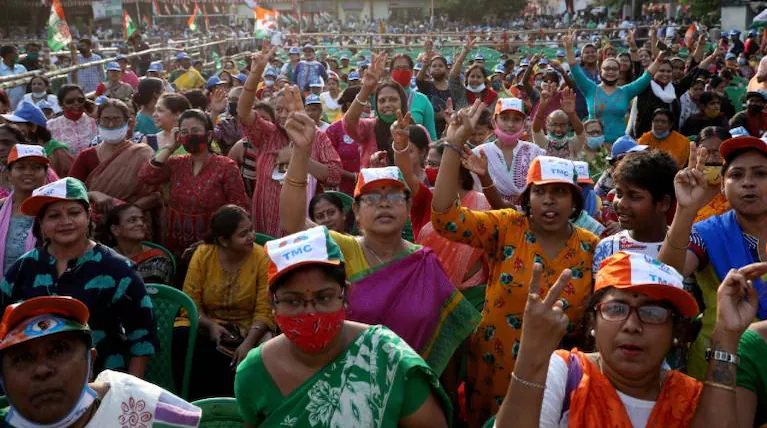by Pradeep Mathur
The ongoing electoral battle being fought in West Bengal is unprecedented in many ways. Never in the nearly seven decades of our democratic polity, an election for a state assembly has generated such nationwide interest and such high decibel noise. Never has a national-level party that is firmly entrenched in power in the Centre, fought an election in a state as though it were a matter of life and death for it. Never has a Prime Minister ever campaigned so much for a state assembly election directly confronting the Chief Minister. Never has the entire party in power at the Centre roped in their high-profile leaders to campaign with such fervor and pitch against the leader of a regional party, who is no less a firebrand and gutsy lady.
Why the BJP is fighting it so hard to wrest power in West Bengal and why has it launched an unrestrained campaign against Chief Minister Mamata Banerjee and her Trinamool Congress is difficult to understand. Equally difficult is to understand is as to what is happening there on the ground level. Though four of the eight rounds are over, nobody has a clear idea as to which way West Bengal is going.
Political pundits, opinion poll experts and election analysts will be reluctant to admit it but the fact is that so far, they have failed to gauge as to which way the wind is blowing in West Bengal. In fact, they are getting increasingly confused with each passing round. Now midway through the elections, they seem to have given up the job of foretelling us about the outcome of elections in West Bengal.
Why political pundits and opinion poll experts are so miserably confused is not difficult to understand. The fact is that traditionally our election analysis is based on three things 1. the voting pattern in earlier election(s); 2. a fixed notion about how creed-caste-class groups play out in terms of preference for a party or a joint front of more than one party and 3. incumbency factor. Sometimes events relating to a communal issue, sectarian clash, or the death of a popular mass leader may create social upheaval and clearly contribute to the mood of the masses, indicative of a wave. Factors like development awareness, literacy level of electorate and improvement or otherwise in social indicators are seldom taken into consideration.
Our political pundits and election analysts are good at understanding these factors, which aides in predicting the outcome of an election, hence making it an easy job for them. If they are finding it difficult to explain the West Bengal election scene this time round, it is because these variables are either missing or have turned complex in nature. Unlike in the Hindi heartland states, which are now BJP’s happy playground, West Bengal’s politics has been deeply affected by ideology that has been entrenched during the 34 year rule by the CPI (M)-led Left Front. This has certainly altered the mass psyche and weakened the emotional appeal of communal and caste factors. Neither the BJP leadership understands this nor the political correspondents covering the election. For instance, they miss a simple point that in West Bengal language, cultural pride, and identity acts as a much bigger binding force than religion. If Muslims are voting (or will vote in coming rounds) en bloc it is not because they want to stand against majority Hindu community or because Mamata as alleged by BJP, has done them some great favour. It will be simply to express their disapproval of BJP’s majoritarian politics which includes “imposition of Hindi” among other things.
No doubt in its later years Left Front rule deviated from it ideological path and many aberrations became apparent. Mamata Banerjee dislodged the Left Front from power by using the same questionable techniques. However, both the Left Front and TMC under Mamata Banerjee’s kept the poor section in the focus and made no secret of their position in being anti-capitalist. The fact that voters in West Bengal view the TMC-BJP confrontation as a battle between the poor and the rich is also being overlooked by the saffron leaders and a media often been used to covering elections on frivolous matters or issues of no direct benefit to the poor.
Unlike in the Hindi heartland, where democratic politics is mostly an extension of the old feudal order, in West Bengal the electorate is more aware and discerning. It is less likely to be motivated by hollow slogans and empty promises made by any party. Perhaps the biggest problem is that the political pundits and election analysts are unwilling to give up their top heavy approach to assess the situation. They must also know that they cannot understand the ground reality by interviewing union ministers addressing rallies in West Bengal and putting some leading questions to a few inarticulate lads on the streets will not connect them to the mood of voters. It is for these reasons they are plainly confused and find themselves in a blind alley. If they want to report the obtaining reality with a fair degree of accuracy they will have to take a bottoms-up approach to understand the mood of the masses in West Bengal, though perhaps a little too late now with elections more than half way through.
Prof Pradeep Mathur is a veteran journalist, and former professor and Course Director at Indian Institute of Mass Communication, New Delhi. He is the Chief Editor of Align India News Portal.


